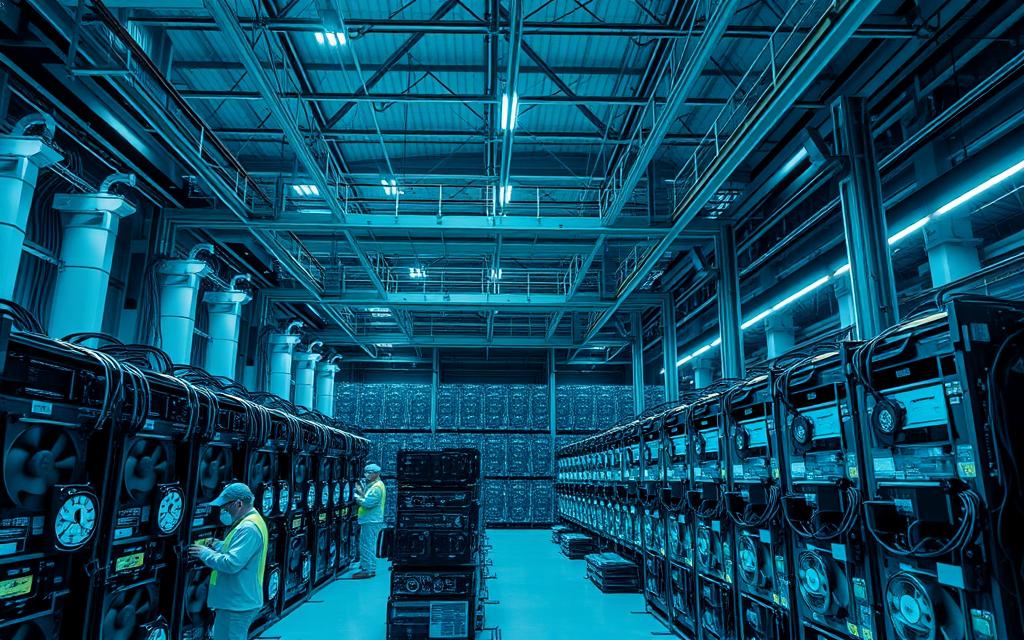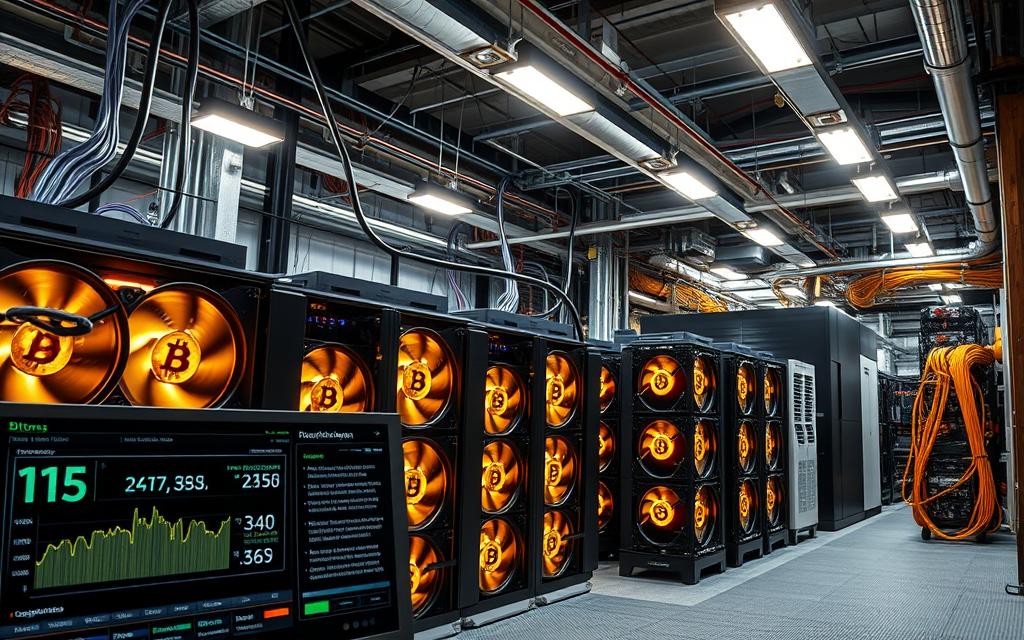Table of Contents
The world of cryptocurrency has witnessed a significant transformation since its inception, with bitcoin mining evolving from a bedroom hobby to a multi-billion dollar industry.
miners collectively generate approximately $20 million worth of Bitcoin daily, with the industry’s profitability depending on various factors, including hardware costs, electricity rates, and blockchain complexity.
The 2024 Bitcoin halving event reduced block rewards to 3.125 BTC, significantly impacting mining economics and forcing miners to optimize operations for profitability.
This comprehensive guide will analyze the current state of mining profitability, examining key factors that determine whether mining remains a viable investment in today’s market.
Understanding Bitcoin Mining in 2025
In 2025, the landscape of Bitcoin mining is shaped by factors such as network difficulty, hardware efficiency, and electricity costs. Bitcoin mining remains a critical component of the cryptocurrency ecosystem, supporting the decentralized nature of the blockchain.
What is Bitcoin Mining?
At its core, Bitcoin mining involves using specialized hardware to solve complex cryptographic puzzles. This process is fundamental to the validation of transactions on the Bitcoin blockchain, a decentralized ledger that records all transactions made with the cryptocurrency. The miners compete to solve these puzzles, and the first to do so successfully gets to add a new block to the blockchain and is rewarded with newly minted Bitcoins.
How Bitcoin Mining Works
The process of Bitcoin mining operates through a competitive mechanism where miners race to find a specific hash value by repeatedly running cryptographic hash functions with different inputs. The network difficulty adjusts approximately every 2,016 blocks to maintain a consistent block discovery rate. As more miners join with increasingly powerful hardware, the difficulty increases, requiring more computational work and electricity to find each new block.
| Key Factors | Description | Impact on Mining |
|---|---|---|
| Network Difficulty | Adjusts every 2,016 blocks | Increases with more miners |
| Hardware Efficiency | Evolves from CPUs to ASIC miners | Improves mining competitiveness |
| Electricity Costs | Significant operational expense | Affects mining profitability |
As the blockchain continues to grow, so does the complexity and security of the network, making it increasingly robust against potential attacks. The interplay between mining difficulty, hardware capabilities, and operational costs defines the current landscape of Bitcoin mining in 2025.
The Current State of Bitcoin Mining Profitability
With the ever-changing dynamics of the cryptocurrency market, assessing Bitcoin mining profitability is crucial. The landscape of Bitcoin mining has undergone significant changes, driven by factors such as electricity costs, mining hardware efficiency, and global regulatory environments.
Post-2024 Halving Impact
The 2024 halving event has had a profound impact on Bitcoin mining profitability. As the block reward decreases, miners face reduced revenue unless compensated by an increase in Bitcoin’s price or reduced operational costs. The halving has forced mining operations to optimize their efficiency and explore alternative energy sources to remain profitable.
| Factor | Pre-Halving | Post-Halving |
|---|---|---|
| Block Reward | 6.25 BTC | 3.125 BTC |
| Mining Revenue | Higher | Lower |
| Operational Costs | Variable | Under Pressure to Reduce |
Global Mining Landscape
The global Bitcoin mining landscape has shifted dramatically, with operations now concentrated in regions offering cheap electricity, favorable regulations, and cooler climates. North America has emerged as a major mining hub, with the United States hosting approximately 40% of global Bitcoin mining operations.

Professional mining companies have established industrial-scale operations, benefiting from economies of scale and access to capital. The adoption of renewable energy sources has accelerated, with operations utilizing hydroelectric, solar, wind, and geothermal power to reduce costs and improve public perception.
Key Factors Affecting Bitcoin Mining Profitability
Understanding the factors that affect Bitcoin mining profitability is crucial for success. Bitcoin mining is a complex process influenced by various elements that can significantly impact the bottom line of mining operations.
Hash Rate and Network Difficulty
The hash rate and network difficulty are fundamental factors that affect mining profitability. As more miners join the network, the difficulty level increases, making it harder to mine Bitcoins. This, in turn, affects the profitability of mining operations, as miners need more powerful hardware to remain competitive.
Bitcoin Price Volatility
Bitcoin price volatility is another critical factor that significantly impacts profitability. When the price of Bitcoin is high, mining is more profitable. Conversely, when the price drops, mining becomes less profitable. Miners must be prepared for price fluctuations and adjust their strategies accordingly.
Mining Hardware Efficiency
The efficiency of mining hardware is also crucial. More efficient hardware can mine more Bitcoins using less energy, thereby increasing profitability. The development of Application-Specific Integrated Circuit (ASIC) miners has significantly improved mining efficiency.
Electricity Costs
Electricity costs are a significant expense for miners, often representing 70-80% of operational costs. Miners seek locations with low electricity costs to maximize profitability. For instance, industrial-scale miners often secure power rates below $0.05 per kilowatt-hour.
| Location | Electricity Cost ($/kWh) | Mining Profitability |
|---|---|---|
| China | 0.045 | $45/month |
| USA (Industrial) | 0.05 | $30/month |
| USA (Residential) | 0.12 | – $20/month (loss) |
As illustrated in the table, electricity costs can significantly impact mining profitability. Miners in regions with low energy costs have a competitive advantage.
Is Bitcoin Mining Profitable for Different Miners?
Bitcoin mining profitability is not a one-size-fits-all scenario. The viability of mining operations depends on various factors, including the scale of operations, geographic location, and access to affordable energy.
Large-Scale Operations vs. Individual Miners
Large-scale mining operations typically have an advantage over individual miners due to their ability to negotiate lower electricity costs and invest in more efficient mining hardware. These operations can also benefit from economies of scale, reducing their overall costs per unit. In contrast, individual miners often face higher operational costs and may struggle to remain profitable, especially after the halving events that reduce block rewards.
- Large-scale operations benefit from lower electricity prices and more efficient hardware.
- Individual miners face higher costs and reduced profitability after halving events.
- Access to affordable energy is crucial for maintaining profitability.
Geographic Considerations
 Geographic location plays a crucial role in determining mining profitability. Regions with abundant hydroelectric power, such as Iceland and Norway, offer some of the lowest energy costs globally, making them attractive for mining operations. Additionally, cooler climates can reduce the need for expensive cooling systems, further lowering operational costs. However, regulatory environments vary significantly across jurisdictions, impacting the overall profitability of mining operations.
Geographic location plays a crucial role in determining mining profitability. Regions with abundant hydroelectric power, such as Iceland and Norway, offer some of the lowest energy costs globally, making them attractive for mining operations. Additionally, cooler climates can reduce the need for expensive cooling systems, further lowering operational costs. However, regulatory environments vary significantly across jurisdictions, impacting the overall profitability of mining operations.
- Regions with hydroelectric power offer low energy costs.
- Cooler climates reduce cooling costs.
- Regulatory environments significantly impact mining profitability.
Mining Hardware and Investment Costs

Miners must carefully consider their hardware investments to remain profitable. The cost of mining hardware is a significant factor in determining mining profitability. When choosing which machine to invest in, miners should think about the machine’s profitability and longevity.
ASIC Miners: Cost vs. Performance
Profitability is determined by the machine’s price per TH, how many watts the machine uses per TH, and your hosting costs. ASIC miners vary significantly in cost and performance. The most efficient machines may offer better returns despite higher upfront costs.
Key considerations include: the machine’s efficiency, measured in watts per terahash (W/TH), and its price per terahash (TH/s). These factors directly impact the miner’s ability to generate returns on their investment.
Hardware Longevity and Depreciation
Longevity is determined by the production quality of the machine. Mining hardware typically experiences both technical and economic obsolescence. Most ASIC miners remain technically functional for 3-5 years but become economically unviable much sooner.
- Mining hardware typically experiences both technical and economic obsolescence, with most ASIC miners remaining technically functional for 3-5 years but becoming economically unviable much sooner.
- Proper maintenance can significantly extend the useful life of mining machines and improve return on investment.
- The residual value of mining hardware depends heavily on Bitcoin’s price and network difficulty.
To maximize returns, miners should focus on efficient hardware and proper maintenance. This includes dust removal, thermal paste replacement, and climate control. Some miners also extend hardware longevity by underclocking their machines, sacrificing some hash rate to reduce power consumption and heat generation.
Mining Methods and Their Profitability
The choice of mining method plays a crucial role in determining the profitability of Bitcoin mining operations. Miners can choose from various methods, each with its advantages and disadvantages.
Self-Built Mining Farms
Self-built mining farms involve setting up and managing one’s own mining hardware. This method requires significant upfront investment in mining machines and infrastructure. However, it offers more control over the mining operation and potentially higher returns.
Cloud Hosting Services
Cloud hosting services for Bitcoin mining eliminate the need for physical hardware. Miners rent computing power from cloud mining providers, reducing initial investment and operational costs. Cloud mining offers flexible contract terms and computing power options, making it accessible to a broader range of investors.
Key benefits include low initial investment, reduced operational costs, and no need to manage physical equipment. However, returns may be lower due to service fees, and there’s a reliance on the trustworthiness of cloud mining providers.

Cloud Mining Contracts
Cloud mining contracts allow individuals to purchase mining power without owning or managing physical hardware. These contracts typically sell hash power in fixed-term agreements, with customers receiving mining rewards proportional to their purchased share of the provider’s total hash rate.
While cloud mining contracts simplify entry into cryptocurrency mining, they often come with lower expected returns compared to direct hardware ownership. Transparency and contract terms vary widely between providers, affecting potential returns.

Strategies to Maximize Bitcoin Mining Profits
To maximize Bitcoin mining profits, miners must employ effective strategies that adapt to the ever-changing market landscape. The mining industry is highly competitive, and staying ahead requires a combination of technical expertise and market savvy.
Optimizing Equipment Efficiency
One key strategy is to optimize equipment efficiency. This can be achieved by regularly updating mining hardware to take advantage of the latest technological advancements. By doing so, miners can increase their hash rate and reduce energy consumption, leading to higher profitability.
Utilizing Renewable Energy Sources
Another crucial aspect is the utilization of renewable energy sources. As bitcoin mining consumes significant amounts of energy, using renewable sources like solar or hydroelectric power can substantially reduce operational costs. This not only enhances profitability but also contributes to a more sustainable mining practice.
Diversifying Mining Operations
Diversifying mining operations is also a viable strategy. By expanding into different mining locations or exploring alternative cryptocurrencies, miners can mitigate risks associated with price volatility and regulatory changes. This diversification can help maintain a stable income stream.
Continuous Market Analysis
Continuous market analysis is essential for making informed decisions. Miners should stay updated on price trends, regulatory developments, and technological advancements. By doing so, they can adjust their strategies to optimize their operations and maximize profits. As emphasized by industry experts, “paying taxes on your mining rewards is a critical aspect that miners must consider, and using crypto tax software can help ensure compliance.”

Conclusion: Is Bitcoin Mining Worth It in 2025?
The year 2025 presents a unique scenario for Bitcoin miners, with the 2024 halving event having a lasting impact on mining profitability. Despite the challenges, Bitcoin mining remains profitable in 2025 for well-positioned operations with access to efficient hardware and low-cost electricity.
The industry has become increasingly professionalized, with large-scale operations enjoying significant advantages through economies of scale, access to capital, and preferential electricity rates. However, individual miners face substantial challenges to profitability unless they have access to exceptionally low electricity costs or specialized circumstances that provide competitive advantages.
Geographic considerations continue to play a crucial role in mining economics, with operations concentrated in regions offering favorable combinations of low electricity costs, cool climates, and supportive regulations. The environmental impact of mining has driven significant innovation in renewable energy utilization, with sustainable mining practices becoming both an ethical consideration and an economic advantage.
Tax implications for mining operations vary widely by jurisdiction and structure, requiring careful planning to ensure compliance while optimizing after-tax returns. The future of mining profitability will be shaped by Bitcoin’s price trajectory, technological advancements in hardware efficiency, and the evolving regulatory landscape across different regions.
In conclusion, while the current landscape presents challenges, the situation may improve in the future once ASIC mining hardware innovation reaches the point of diminishing returns, coupled with cheap and sustainable power solutions. This comprehensive guide has explored the multifaceted factors affecting Bitcoin mining profitability in 2025, providing readers with the knowledge needed to evaluate mining as an investment opportunity. For those considering entering the mining industry, careful analysis of personal circumstances, resources, and risk tolerance remains essential.
FAQ
What are the primary factors that affect the profitability of Bitcoin mining?
The primary factors include the current Bitcoin price, network difficulty, hash rate, electricity costs, and the efficiency of mining hardware. These elements can significantly impact the returns on investment for miners.
How does the halving event impact Bitcoin mining profitability?
The halving event reduces the block reward for miners, potentially decreasing their revenue unless the Bitcoin price increases sufficiently to offset the reduced reward. This event can lead to a shift in the mining landscape, favoring more efficient operations.
What is the role of electricity costs in determining mining profitability?
Electricity costs are a crucial factor, as they directly affect the operational expenses of miners. Regions with lower electricity rates can provide a competitive advantage to mining operations.
How do large-scale mining operations compare to individual miners in terms of profitability?
Large-scale operations often benefit from economies of scale, accessing cheaper electricity and more efficient hardware, which can enhance their profitability compared to individual miners.
What are the advantages of using renewable energy sources for Bitcoin mining?
Utilizing renewable energy sources can reduce electricity costs and minimize the environmental impact of mining operations, potentially increasing profitability and sustainability.
How does the efficiency of mining hardware impact profitability?
More efficient mining hardware can increase the hash rate while reducing energy consumption, directly influencing the profitability of mining operations by lowering operational costs.
What strategies can miners employ to maximize their profits?
Miners can optimize their operations by improving equipment efficiency, utilizing renewable energy, diversifying their mining activities, and conducting continuous market analysis to make informed decisions.
Are cloud mining contracts a viable option for profitable Bitcoin mining?
Cloud mining contracts can be a viable option, offering a way to participate in Bitcoin mining without directly managing hardware. However, their profitability depends on the contract terms, the provider’s reliability, and the underlying mining hardware efficiency.









